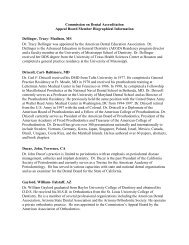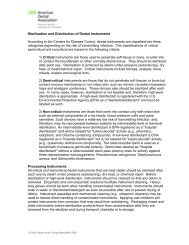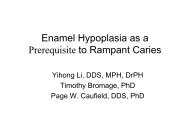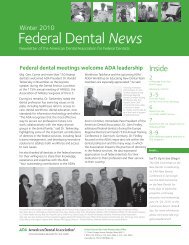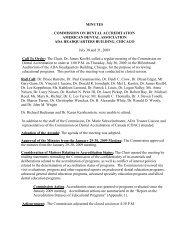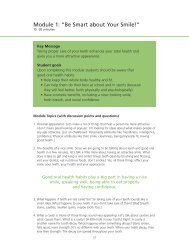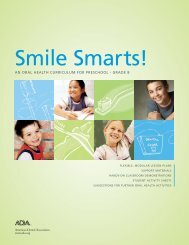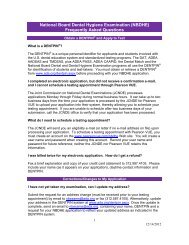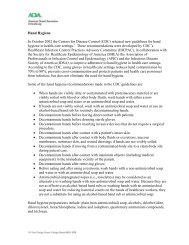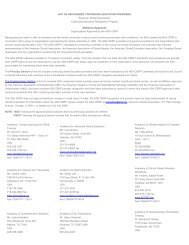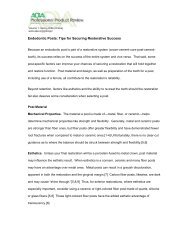Posterior Composites - American Dental Association
Posterior Composites - American Dental Association
Posterior Composites - American Dental Association
You also want an ePaper? Increase the reach of your titles
YUMPU automatically turns print PDFs into web optimized ePapers that Google loves.
ADA Professional Product Review 1<br />
<strong>Posterior</strong> <strong>Composites</strong>: Laboratory Testing Methods<br />
Volume 1: Issue 1 Summer 2006 (Online)<br />
www.ada.org/goto/ppr<br />
Scope<br />
ADA Professional Product Review<br />
<strong>Posterior</strong> <strong>Composites</strong>: Laboratory Testing Methods<br />
This protocol for the laboratory testing of posterior composites was developed to provide clinically<br />
relevant laboratory information that will be used as part of a report on posterior composites in the<br />
July 2006 issue of the ADA Professional Product Review. When surveyed, the ADA Clinical<br />
Evaluators (ACE) panel identified wear and shrinkage as important features to be evaluated in the<br />
laboratory. Also, strength, shade/color stability, polishability, and depth of cure were indicated<br />
multiple times as areas of interest. The tests described in this protocol should provide the dental<br />
practitioner with appropriate comparative scientific information to assist in the purchase of<br />
posterior composites.<br />
General Information<br />
All tests were performed with the A3 enamel shade.<br />
Tests in This Protocol<br />
A. Depth of Cure<br />
B. Flexural Strength and Flexural Modulus<br />
C. Water Sorption and Solubility<br />
D. Shade Matching and Color Stability After Water Sorption<br />
E. Radiopacity<br />
F. Polishability<br />
G. Shrinkage<br />
Document posted 2006<br />
© 2006 <strong>American</strong> <strong>Dental</strong> <strong>Association</strong>
ADA Professional Product Review 2<br />
<strong>Posterior</strong> <strong>Composites</strong>: Laboratory Testing Methods<br />
Volume 1: Issue 1 Summer 2006 (Online)<br />
www.ada.org/goto/ppr<br />
Depth of Cure<br />
Identifies the depth of cure achieved according to the manufacturer’s recommended curing time<br />
and offers guidance on the maximum increment-thickness that can be cured under similar<br />
conditions. Darker shades, lower light intensity, and increased distance between the light tip and<br />
the composite will decrease the maximum depth of cure.<br />
Sampling: The test sample shall consist of packages prepared for retail sale from the same<br />
batch and containing enough material to carry out the specified tests, plus an<br />
allowance for repeat tests, if necessary (50 g should be sufficient).<br />
Materials: Stainless steel mold for the preparation of test specimens. Mold should be<br />
6 mm long × 4 mm in diameter, unless the manufacturer claims a depth of cure in<br />
excess of 3 mm; in this event, the mold shall be at least 2 mm longer than twice the<br />
claimed depth of cure.<br />
Two glass slides/plates, each of sufficient area to cover one side of the mold<br />
(standard glass microscope slides may be used)<br />
White filter paper<br />
Film, transparent to the activating radiation, e.g., polyester, 50 ±30 μm thick<br />
External energy source (note that the light intensity should be measured according to<br />
ISO 10650, 3 and the intensity should be above 300 mW/cm 2 ). Include a mylar strip<br />
between the light and the filters while recording the light intensity.<br />
Micrometer accurate to 0.01 mm<br />
Plastic spatula<br />
Procedure: See 7.10 of ANSI/ADA Spec 27 1 or 7.10 of ISO 4049 2<br />
Document posted 2006<br />
© 2006 <strong>American</strong> <strong>Dental</strong> <strong>Association</strong>
ADA Professional Product Review 3<br />
<strong>Posterior</strong> <strong>Composites</strong>: Laboratory Testing Methods<br />
Volume 1: Issue 1 Summer 2006 (Online)<br />
www.ada.org/goto/ppr<br />
Flexural Strength and Flexural Modulus<br />
Represents the composite’s ability to initially withstand occlusal stress and flex under load, but<br />
does not predict resistance to wear or fatigue.<br />
Sampling: The test sample shall consist of packages prepared for retail sale from the same<br />
batch and containing enough material to carry out the specified tests, plus an<br />
allowance for repeat tests, if necessary (50 g should be sufficient).<br />
Materials: Stainless steel mold for the preparation of test specimens. Mold should be<br />
25 ±2 mm × 2 ±0.1 mm × 2 ±0.1 mm (see Figure 7 of ANSI/ADA Spec 271 or ISO<br />
4049 2 ).<br />
One metal plate of sufficient area to cover one side of the mold<br />
Glass microscope slide for use during polymerization<br />
Small clamp<br />
Film, transparent to the activating radiation, e.g. polyester, 50 ±30 μm thick<br />
White filter paper<br />
Water bath capable of being maintained at 37 ±1ºC<br />
External energy source (Note: the light intensity should be measured according to<br />
ISO 10650, 3 and the intensity should be above 300 mW/cm 2 ). Include a mylar strip<br />
between the light and the filters while recording the light intensity.<br />
Micrometer accurate to 0.01 mm<br />
Mechanical test machine appropriately calibrated to provide a constant crosshead<br />
speed of 0.75 ±0.25 mm/min or a rate of loading of 50 ±16 N/min<br />
Flexural strength test apparatus, the apparatus consists essentially of two rods (2 mm<br />
in diameter), mounted parallel with 20 mm between centers, and a third rod (2 mm<br />
in diameter) centered between, and parallel to, the other two, so that the three rods in<br />
combination can be used to give a three-point loading to the specimen.<br />
Procedure: See 7.11 of ANSI/ADA Spec 27 1 or 7.11 of ISO 4049 2<br />
Document posted 2006<br />
© 2006 <strong>American</strong> <strong>Dental</strong> <strong>Association</strong>
ADA Professional Product Review 4<br />
<strong>Posterior</strong> <strong>Composites</strong>: Laboratory Testing Methods<br />
Volume 1: Issue 1 Summer 2006 (Online)<br />
www.ada.org/goto/ppr<br />
Water Sorption and Solubility<br />
Indicates the amount of shrinkage for one hour after polymerization and the rate of stress<br />
development the adhesive would be subjected to during this time. Theoretically, a lower maximum<br />
shrinkage stress and a slower rate of stress development would be advantageous to maintain<br />
marginal integrity, prevent microleakage, and may limit post-operative sensitivity.<br />
Sampling: The test sample shall consist of packages prepared for retail sale from the same<br />
batch and containing enough material to carry out the specified tests, plus an<br />
allowance for repeat tests, if necessary (50 g should be sufficient).<br />
Materials: Mold of internal dimensions 15 ±0.1 mm in diameter and 1.0 ±0.1 mm deep, for the<br />
preparation of specimen discs. A split ring or “washer” mold is suitable. To aid<br />
release of the specimen from the mold, the inner surface of the ring can be lubricated<br />
with a 3% solution of polyvinyl ether wax in hexane.<br />
Film transparent to the activating radiation, e.g., polyester, 50 ±30 μm thick<br />
Two metal plates, each of sufficient area to cover one side of the mold<br />
Two dessicators containing silica gel freshly dried for 5 h at 130ºC. Replace the<br />
silica gel with freshly dried gel after each weighing sequence.<br />
External energy source (note that the light intensity should be measured according to<br />
ISO 10650, 3 and the intensity should be above 300 mW/cm 2 ). Include a mylar strip<br />
between the light and the filters while recording the light intensity.<br />
Oven capable of being maintained at 37 ±1ºC<br />
Analytical balance accurate to 0.05 mg. IMPORTANT: unless specified, weight<br />
measurements should be made at room temperature 23 ±1ºC and humidity 50 ±5%.<br />
Micrometer accurate to 0.01 mm<br />
Plastic tweezers. To avoid contamination of the specimens, they should be handled<br />
at all times with the tweezers.<br />
Hand dust blower or source of oil-free compressed air with micro-jet nozzle<br />
Procedure: See 7.12 of ANSI/ADA Spec 27 1 or 7.12 of ISO 4049 2<br />
Document posted 2006<br />
© 2006 <strong>American</strong> <strong>Dental</strong> <strong>Association</strong>
ADA Professional Product Review 5<br />
<strong>Posterior</strong> <strong>Composites</strong>: Laboratory Testing Methods<br />
Volume 1: Issue 1 Summer 2006 (Online)<br />
www.ada.org/goto/ppr<br />
Shade Matching and Color Stability After Water Sorption<br />
Shade matching verifies the color match between the cured composite and the manufacturer’s<br />
recommended shade guide fore that product. Color stability is a screening test that checks whether<br />
the color of the material initially will remain stable in a moist environment. .<br />
Sampling: The test sample shall consist of packages prepared for retail sale from the same<br />
batch and containing enough material to carry out the specified tests, plus an<br />
allowance for repeat tests, if necessary (50 g should be sufficient).<br />
Materials: Same as for WATER SORPTION AND SOLUBILITY test above.<br />
Procedure: See 7.13 of ANSI/ADA Spec 27 1 or 7.13 of ISO 4049 2<br />
Document posted 2006<br />
© 2006 <strong>American</strong> <strong>Dental</strong> <strong>Association</strong>
ADA Professional Product Review 6<br />
<strong>Posterior</strong> <strong>Composites</strong>: Laboratory Testing Methods<br />
Volume 1: Issue 1 Summer 2006 (Online)<br />
www.ada.org/goto/ppr<br />
Radiopacity<br />
Shows how identifiable the composite will be on a radiograph<br />
Sampling: The test sample shall consist of packages prepared for retail sale from the same<br />
batch and containing enough material to carry out the specified tests, plus an<br />
allowance for repeat tests, if necessary (50 g should be sufficient).<br />
Materials: Same as in the WATER SORPTION AND SOLUBILITY test plus the following:<br />
Single-phase dental x-ray unit with a total filtration of 1.5 mm aluminum and<br />
capable of operation at 65 ±5 kV, with suitable accessories<br />
<strong>Dental</strong> x-ray film of speed group D, developing solution and fixer<br />
Aluminum step wedge, purity at least 98% (mass fraction) with less than 0.1%<br />
(mass fraction) copper and less than 1.0% (mass fraction) iron present, 50 mm long<br />
× 20 mm wide, having a thickness range from 0.5 mm to 5.0 mm in equally spaced<br />
steps of 0.5 ±0.01 mm. The wedge should be free-standing.<br />
Sheet of lead not less than 2 mm thick<br />
Photographic densitometer capable of measuring in the range of 0.5 to 2.5 optical<br />
density<br />
Micrometer accurate to 0.01 mm<br />
Procedure: See 7.14 of ANSI/ADA Spec 27 1 or 7.14 of ISO 4049 2<br />
Document posted 2006<br />
© 2006 <strong>American</strong> <strong>Dental</strong> <strong>Association</strong>
ADA Professional Product Review 7<br />
<strong>Posterior</strong> <strong>Composites</strong>: Laboratory Testing Methods<br />
Volume 1: Issue 1 Summer 2006 (Online)<br />
www.ada.org/goto/ppr<br />
Polishability<br />
Demonstrates the ability to attain maximum surface gloss with a polishing system<br />
Sampling: The test sample shall consist of packages prepared for retail sale from the same<br />
batch and containing enough material to carry out the specified tests, plus an<br />
allowance for repeat tests, if necessary (50 g should be sufficient).<br />
Materials: Stainless steel mold for the preparation of test specimens. Mold should be<br />
25 ±2 mm × 2 ±0.1 mm × 2 ±0.1 mm (see Figure 7 of ANSI/ADA Spec 27 1 or ISO<br />
4049 2 )<br />
One metal plate of sufficient area to cover one side of the mold<br />
Glass microscope slide for use during polymerization<br />
Small clamp<br />
Film, transparent to the activating radiation, e.g. polyester, 50 ±30 μm thick<br />
White filter paper<br />
Water bath capable of being maintained at 37 ±1ºC<br />
External energy source (note that the light intensity should be measured according to<br />
ISO 10650, 3 and the intensity should be above 300 mW/cm 2 ). Include a mylar strip<br />
between the light and the filters while recording the light intensity.<br />
Micrometer accurate to 0.01 mm<br />
Sectioning saw with diamond blade (IsoMet saw, Buehler Ltd.)<br />
Profilometer (Surtronic 3+, Taylor Hobson Ltd.)<br />
Polishing discs (Sof-Lex 3M ESPE), medium, fine, and super fine<br />
Procedure: 1. Cover the metal plate with the filter paper, followed by the polyester film, and<br />
position the mold on it.<br />
2. Prepare the material in accordance with the manufacturer’s instructions and fill<br />
the mold with the material.<br />
Document posted 2006<br />
© 2006 <strong>American</strong> <strong>Dental</strong> <strong>Association</strong>
ADA Professional Product Review 8<br />
<strong>Posterior</strong> <strong>Composites</strong>: Laboratory Testing Methods<br />
Volume 1: Issue 1 Summer 2006 (Online)<br />
www.ada.org/goto/ppr<br />
Polishability, cont’d.<br />
3. Place a second piece of polyester film onto the material in the mold and cover this<br />
with the glass microscope slide.<br />
4. Place the exit window of the external energy source at the center of the specimen<br />
and against the glass plate.<br />
5. Irradiate that section of the specimen for the recommended exposure time.<br />
6. Move the exit window to the section next to the center, overlapping the previous<br />
section by half the diameter of the exit window, and irradiate for the appropriate<br />
time. Then irradiate the section on the other side of the center in the same way.<br />
Continue this procedure until the entire length of the specimen has been irradiated<br />
for the recommended exposure time.<br />
7. Turn the mold over and repeat the irradiation procedure on the other side of the<br />
specimen.<br />
8. Use the sectioning saw with the diamond blade to cut the 25 mm × 2 mm × 2mm<br />
rectangular specimens into thirds, resulting in three 8 mm × 2 mm × 2mm<br />
rectangular specimens. A total of six 8 mm × 2 mm × 2mm rectangular specimens<br />
are required for each product.<br />
9. For each specimen, designate one of the rectangular, 8 mm × 2 mm surfaces to be<br />
the top. Then, using a profilometry system, analyze the top of each specimen and<br />
record its baseline surface roughness (Ra) and the baseline maximum roughness<br />
(Rz).<br />
10. For each specimen, polish the side of the specimen that is analyzed by the<br />
profilometry system (the top side). The polishing procedure shall simulate<br />
clinical conditions by using a series of medium, fine and super fine polishing<br />
discs. Polish each specimen for 30 sec with medium, 30 sec with fine, and<br />
15 sec with super fine polishing discs.<br />
11. Using a profilometry system, analyze the polished surface of each specimen<br />
three times and record the surface roughness (Ra) and the maximum roughness<br />
(Rz) of the polished surface.<br />
12. Repeat for all six specimens.<br />
13. For each product, report the average surface roughness (Ra) and the average<br />
maximum roughness (Rz) of the polished surfaces, along with their standard<br />
deviations.<br />
Document posted 2006<br />
© 2006 <strong>American</strong> <strong>Dental</strong> <strong>Association</strong>
ADA Professional Product Review 9<br />
<strong>Posterior</strong> <strong>Composites</strong>: Laboratory Testing Methods<br />
Volume 1: Issue 1 Summer 2006 (Online)<br />
www.ada.org/goto/ppr<br />
Shrinkage<br />
(see Shrinkage Testing Method PDF)<br />
References<br />
1. <strong>American</strong> National Standard/<strong>American</strong> <strong>Dental</strong> <strong>Association</strong> Specification No. 27—2005, Resinbased<br />
Filling Materials. Chicago: <strong>American</strong> <strong>Dental</strong> <strong>Association</strong>.<br />
www.ada.org/prof/resources/positions/standards/denmat.asp#ansi<br />
2. International Organization for Standardization. ISO No. 4049:2000, Dentistry—Polymer-Based<br />
Filling, Restorative and Luting Materials. Geneva: ISO. www.iso.org<br />
3. International Organization for Standardization. ISO No. 10650-1:2004, Dentistry—Powered<br />
Polymerization Activators—Part 1: Quartz Tungsten Halogen Lamps. Geneva: ISO.<br />
www.iso.org<br />
4. ASTM International. ASTM E399-90 (1997) Standard Test Method for Plane-Strain Fracture<br />
Toughness of Metallic Materials. West Conshocken, PA: ASTM International. www.astm.org<br />
Document posted 2006<br />
© 2006 <strong>American</strong> <strong>Dental</strong> <strong>Association</strong>



